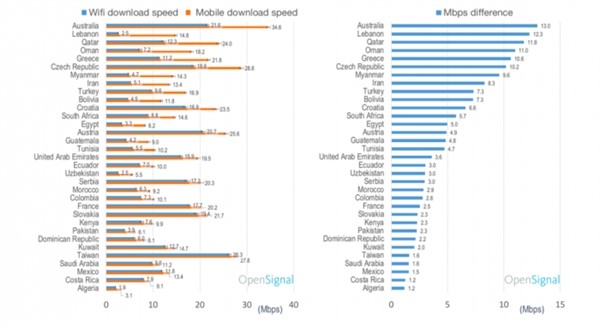Guide: According to British media reports, Mansoor Hanif, Ofcom's chief technology officer, stressed that Wi-Fi is being marginalized, mainly due to the growing strength of mobile networks. Statistics from OpenSignal, a research institute, show that the average speed of mobile networks in many countries and regions has exceeded the speed of Wi-Fi connections.

Of course, if the mobile network wants to get rid of Wi-Fi, there is still a problem of tariff. With the increase of the speed of mobile network, if the tariff can be cheaper, at the same time, the operators give more traffic to support this behavior.
At present, whenever possible, everyone's mobile phones will be connected to Wi-Fi network, provided that Wi-Fi network will provide better Internet connection. But this is increasingly not the case. Under all the same conditions, more mobile phones will push more users to a worse experience.
Whether the upcoming 5G network will accelerate the marginalization of Wi-Fi is unknown, but as the speed of mobile network increases, people may no longer be as easy as before to link to Wi-Fi network, are you?
What is NBIOT?
Narrow Band Internet of Things (NB-IoT) has become an important branch of Internet of all things. NB-IoT is built in cellular network and consumes only about 180 KHz bandwidth. It can be directly deployed in GSM network, UMTS network or LTE network to reduce deployment cost and achieve smooth upgrade.
NB-IoT is a new technology in the field of IoT. It supports low power devices' cellular data connection in WAN. It is also called low power wide area network (LPWAN). NB-IoT supports efficient connection of devices with long standby time and high network connection requirements. It is said that the battery life of NB-IoT devices can be increased by at least 10 years, while providing a very comprehensive coverage of indoor cellular data connections.
Prospect and Strength:
Mobile communication is advancing from the connection between people and people to the connection between people and things, and the interconnection of things is an inevitable trend. However, the current 4G network has insufficient ability to connect objects to objects. In fact, compared with Bluetooth, ZigBee and other short-distance communication technologies, mobile cellular network has the characteristics of wide coverage, mobility and large number of connection, which can bring more abundant application scenarios, and should become the main connection IoT technology. As an evolutionary technology of LTE, 4.5G not only has a peak speed of up to 1Gbps, but also means more connections based on cellular IoT, supporting M2M connections and lower latency, which will promote the rapid popularization of HD video, VoLTE and IoT applications. The cellular IoT is opening an unprecedented broad market.
For Telecom operators, IoT applications such as Vehicle Networking, Intelligent Medical, Smart Home and so on will generate connections, far exceeding the communication needs between people.
NB-IoT has four characteristics: 1. the wide coverage, which will provide improved indoor coverage. In the same frequency band, NB-IoT gains 20 dB compared with the existing network, which is equivalent to 100 times the coverage area. 2. the ability to support connections. One sector of NB-IoT can support 100,000 connections, and support low delay sensitivity. Ultra-low equipment cost, low equipment power consumption and optimized network architecture. 3. Lower power consumption. NB-IoT terminal module standby time can be up to 10 years. 4. lower module cost. The company expected a single connection module not to exceed $5.
NB-IOT focuses on the low power and wide coverage (LPWA) Internet of Things (IOT) market, which is a new technology that can be widely used worldwide. It has the characteristics of wide coverage, multiple connections, low speed, low cost, low power consumption and excellent architecture. NB-IOT uses license band and can be deployed in-band, protection band or independent carrier, coexisting with existing networks.
Because of its advantages of low power consumption, wide coverage, low cost and large capacity, NB-IoT can be widely used in many vertical industries, such as remote meter reading, asset tracking, intelligent parking, intelligent agriculture, etc.
Many operators, including Chinese operators, are developing NB-IoT and research. On the current development of NB-IoT, Yuquan elaborated three brilliant points: First, NB-IoT is an important opportunity for the honeycomb industry to cope with the interconnection of all things. Second, to succeed, NB-IoT must establish an open industrial platform. Third, 2016 is a critical year for the NB-IoT industry. Standards, chips, networks and commercial application scenarios will be mature.
Qualcomm's new WiFi chip: 10 Gbps in speed
Qualcomm launched the first two 60 GHz Wi-Fi chipsets, QCA64x8 and QCA64x1, which can provide up to 10+Gbps network speed and low latency for mobile phones, laptops, routers, etc., and lower power consumption. Qualcomm said that this is the industry's first 60 GHz Wi-Fi solution based on the new WiGig standard 802.11ay, which can achieve the best 60 GHz Wi-Fi speed and unparalleled coverage performance.
Qualcomm has released a new generation of WiFi chips: 802.11ay based, with a speed of up to 10Gbps.
These new WiFi chips will enable new gaming and entertainment experiences, such as 4K live streaming media, delay-free mobile screen projection to entertainment systems, and real-life wireless virtual and enhanced real-world experience, all of which will not significantly affect the battery life of mobile devices.
In addition to improving performance, these new WiFi chipsets also have always-on environment Wi-Fi sensing capabilities, enabling devices to recognize people, objects, movements and precise locations without being affected by light conditions.
Qualcomm QCA64x8 and QCA64x1 have been launched for global OEM manufacturers.
It is worth mentioning that this type of Wi-Fi is based on the WiGig standard and is used for very special purposes, such as replacing VR header display data lines with high-speed wireless connections, which can be regarded as a single-purpose wireless cable rather than a traditional Wi-Fi connection. WiGig relies on a connection standard called 802.11ad. Qualcomm's latest chip pushes WiGig to a new generation of wireless standard called 802.11ay. Since it's so fast, why not use it as a common Wi-Fi Internet connection? Because there must be no object blocking between the transmitter and the receiver, this means that it is difficult to penetrate barriers, such as walls. Therefore, it is problematic to use it to access the Internet. That is why 802.11ay, like 802.11ad before, is used as an auxiliary technology of existing Wi-Fi technology.
What is computer room monitoring?
Computer room monitoring is mainly aimed at centralized monitoring and management of all equipment and environment in the computer room. Its monitoring object consists of various subsystems of the computer room: power system, environmental system, fire fighting system, security system, network system, etc. The computer room monitoring system is based on the network integrated wiring system, which adopts distributed monitoring. The monitoring host is placed in the computer room monitoring room, and the monitoring software is run to centralize the monitoring of each subsystem with a unified interface. Computer room monitoring system monitors the running status and working parameters of each system equipment in real time, finds out the fault of components or abnormal parameters, and adopts multimedia animation, voice, telephone, short message and other alarm modes to record historical data and alarm events, providing intelligent expert diagnostic suggestions and remote monitoring and management functions as well as WEB browse and so on.
Seriallink mainly offers computer room monitoring industry: serial port networking server, short message alarm module and other products.


